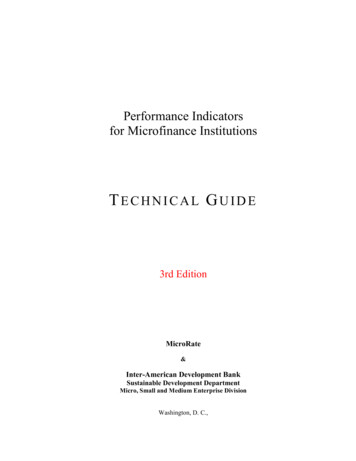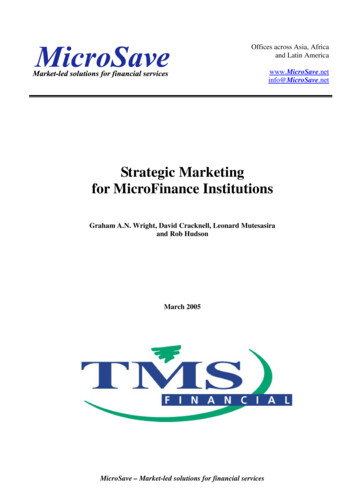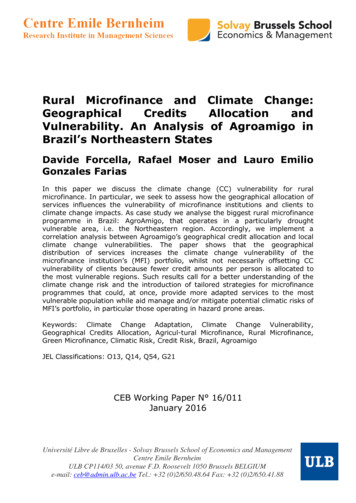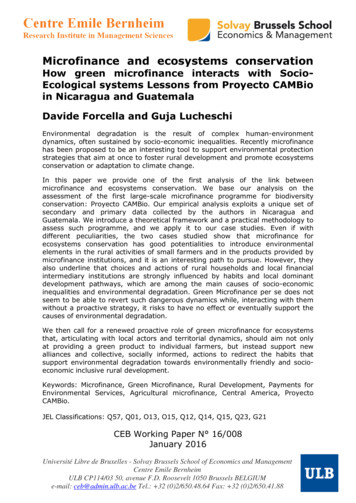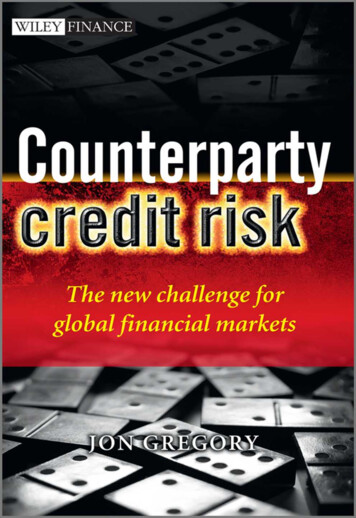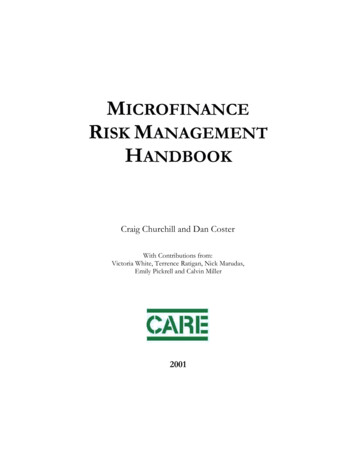
Transcription
MICROFINANCERISK MANAGEMENTHANDBOOKCraig Churchill and Dan CosterWith Contributions from:Victoria White, Terrence Ratigan, Nick Marudas,Emily Pickrell and Calvin Miller2001
CARE MICROFINANCE HANDBOOKChapter 1: Risk Assessment FrameworkMost microfinance institutions are small and unprofitable, and they operate withoutsystems that adequately reduce risk. Although the microfinance literature focuseson success stories, such as BancoSol in Bolivia or BRI’s microfinance units inIndonesia, these organizations are exceptional. For microfinance programsstriving to fulfill their dual mission of sustainability and outreach to the poor, CAREsuggests implementing the risk assessment framework that addresses two agendas:1. Financial Health2. Institutional DevelopmentA standard risk assessment of a financial institution typically addresses the first issue only.In assessing the financial health of a bank or other financial institution, one would considerthe organization’s asset and liability management, including credit risk, as well as operationalrisks such as fraud and inefficiency.Microfinance risk assessment also needs to embrace an institutional developmentperspective. As MFIs evolve from donor dependency to commercial independence, clearvision, reliable systems, effective governance and staff capacity become critical in their abilityto manage risk.This integrated risk assessment framework for MFIs, which analyzes institutionaldevelopment and financial health issues, is organized into four categories of risk:institutional, operational, financial, and external (see Figure 2). This framework providesmanagers and directors of microfinance institutions with a step-by-step means of assessing theirorganization’s current and potential vulnerabilities.1.1 Institutional RisksMicrofinance success is defined as an independent organization providing financial servicesto large numbers of low-income persons over the long-term. An assessment of risks againstthis definition results in three categories of institutional risk: social mission, commercialmission, and dependency.6
CHAPTER1Figure 2: Categories of Microfinance RisksInstitutional RisksSocial MissionCommercial MissionDependencyOperational RisksFinancialManagement RisksCreditFraudSecurityAsset and LiabilityInefficiencySystem IntegrityExternal RisksRegulatoryCompetitionDemographicPhysical EnvironmentMacroeconomic1.1.1 Social MissionWhile all MFIs do not have the same mission statements, in general they have a dualmission: a social mission and a commercial mission. Their social mission is to providevalued financial services to large volumes of low-income persons that will enable them toimprove their welfare. Microfinance institutions are vulnerable to social mission risk if theydo not have a clearly defined target market and monitoring mechanisms to ensure that theyare providing appropriate financial services to their intended clientele.1.1.2 Commercial MissionThe commercial mission of MFIs is to provide financial services in a way that allows theorganization to be an on-going concern; that is, to exist for the long-term as a self-sufficientorganization. MFIs are exposed to commercial mission risk if they do not set interest rateshigh enough to cover costs and if they are not managed as a business.The social and commercial missions sometimes conflict with each other. For example,offering larger loans might make it easier to become sustainable, but this could underminethe social mission to serve low-income and harder-to-reach people who traditionally demandsmaller loans. The microfinance challenge is to balance the social and commercial missionsto achieve them both.1.1.3 DependencyDependency risk is similar to commercial mission risk, but it is most pronounced for MFIsstarted and supported by international organizations such as CARE, particularly when the7
CARE MICROFINANCE HANDBOOKmicrofinance activities are operated as a project rather than as an independent organization.These MFIs are vulnerable to dependency on support provided by the external organization.While this support may initially seem like an advantage, it can significantly undermine effortsto build an independent institution that will exist for the long-term.1.2 Operational RisksOperational risks are the vulnerabilities that an MFI faces in its daily operations, includingportfolio quality (credit risk), fraud risk and theft (security risk).1.2.1 CreditAs with any financial institution, the biggest risk in microfinance is lending money and notgetting it back. Credit risk is a particular concern for MFIs because most microlending isunsecured (i.e., traditional collateral is not often used to secure microloans).To determine an institution’s vulnerability to credit risk, one must review the policies andprocedures at every stage in the lending process to determine whether they reducedelinquencies and loan losses to an acceptable level. These policies and procedures includethe loan eligibility criteria, the application review process and authorization levels, collateralor security requirements, as well as the “carrots and sticks” used to motivate staff andcompel borrowers to repay. In addition to analyzing whether these policies and proceduresare sound, it is also necessary to determine whether they are actually being implemented.The best policies in the world are meaningless if staff members are not properly trained toimplement them or choose not to follow them.1.2.2 FraudAny organization that handles large volumes of money is extremely vulnerable to fraud, avulnerability that tends to increase in poor economic environments. Exposure to fraud isparticularly acute where money changes hands. These vulnerabilities in a microfinanceinstitution can be exacerbated if the organization has a weak information managementsystem, if it does not have clearly defined policies and procedures, if it has high staffturnover, or if the MFI experiences rapid growth. The management of savings deposits,particularly voluntary savings, creates additional vulnerability in that a failure to detect fraudcould lead to the loss of clients’ very limited cash assets and to the rapid deterioration of theinstitution’s reputation. In the detection of fraud, it is critical to identify and address theproblem as quickly as possible to send a sharp message to staff before it gets out of hand.1.2.3 SecurityAs with vulnerability to fraud, the fact that most MFIs handle money also exposes them totheft. This exposure is compounded by the fact the MFIs tend to operate in environmentswhere crime is prevalent or where, because of poverty, temptation is high. For example, inhigh volume branches the amount of cash collected on a repayment day can easily exceedthe average annual household income in that community.8
CHAPTER11.3 Financial Management Risks1.3.1 Asset and LiabilityThe financial vulnerability of an MFI is summarized in asset and liability risks, which includeinterest rate, liquidity, and foreign exchange risks. Interest rate risk rises when the termsand interest rates of the MFI’s assets and liabilities are mismatched. For example, if theinterest rate on short-term liabilities rises before an MFI can adjust its lending rate, thespread between interest earnings and interest payments will narrow, seriously affecting theMFI’s profit margin. MFIs operating in inflationary environments are particularly vulnerableto this type of risk. Liquidity risk involves the possibility of borrowing expensive shortterm funds to finance immediate needs such as loan disbursement, bill payments, or debtrepayment. MFIs are most vulnerable to foreign exchange risk if they have to repay loansin a foreign currency that they have converted to local currency and therefore are earningrevenue in the local currency.1.3.2 InefficiencyEfficiency remains one of the greatest challenges for microfinance institutions. It reflects anorganization’s ability to manage costs per unit of output, and thus is directly affected by bothcost control and level of outreach. Inefficient microfinance institutions waste resources andultimately provide clients with poor services and products, as the costs of these inefficienciesare ultimately passed on to clients through higher interest rates and higher client transactioncosts.1.3.3 System IntegrityAnother aspect of financial management risk is the integrity of the information system,including the accounting and portfolio management systems. An assessment of this riskinvolves checking the quality of the information entering the system, verifying that thesystem is processing the information correctly, and ensuring that it produces useful reportsin a timely manner.1.4 External RisksAlthough MFI managers and directors have less control over external risks, they shouldnonetheless assess the external risks to which they are exposed. A microfinance institutioncould have relatively strong management and staff, and adequate systems and controls, butstill be prone to major problems stemming from the environment in which it operates.External risks are usually outside the control of the MFI, however it is important that theserisks are perceived as challenges that the MFI should address, rather than excuses for poorperformance.9
CARE MICROFINANCE HANDBOOK1.4.1 RegulatoryPolicy makers, banking superintendents and other regulatory bodies are becomingincreasingly interested in, and concerned about, microfinance institutions. This concern isheightened when MFIs are involved in financial intermediation—taking savings from clientsand then lending them out to other clients or institutions. Regulations that can createvulnerability in an MFI include restrictive labor laws, usury laws, contract enforcementpolicies, and political interference.1.4.2 CompetitionIn some environments, microfinance is becoming increasingly competitive, with new players,such as banks and consumer credit companies, entering the market. Competition risks stemsfrom not being sufficiently familiar with the services of others to position, price, and sellyour services. Competition risk can be exacerbated if MFIs do not have access toinformation about applicants’ current and past credit performance with other institutions.1.4.3 DemographicSince most MFIs target disadvantaged individuals in low-income communities, microfinancemanagers need to be aware of how the characteristics of this target market increase theinstitution’s vulnerability. In assessing demographic risks, consider the trends andconsequences of illness and death (including HIV/AIDS), education levels, entrepreneurialexperience, the mobility of the population, social cohesiveness of communities, pastexperience of credit programs, and local tolerance for corruption.1.4.4 Physical EnvironmentSome areas are prone to natural calamities (floods, cyclones, or drought) that affecthouseholds, enterprises, income streams and microfinance service delivery. In addition, thephysical infrastructure—such as transportation, communications, and the availability ofbanks—in the MFI’s area of operations can substantially increase its vulnerability.1.4.5 MacroeconomicMicrofinance institutions are especially vulnerable to changes in the macroeconomicenvironment such as devaluation and inflation. This risk has two facets: 1) how theseconditions affect the MFI directly and 2) how they affect the MFI’s clients, their businessoperations, and their ability to repay their loans.1.5 ConclusionThe management and board of a microfinance institution should consider each of the risksidentified in this chapter as vulnerability points. It is their responsibility to assess theinstitution’s level of exposure, prioritize areas of greatest vulnerability, and to ensure thatproper controls are in place to minimize the MFI’s exposure. The next four chapters'10
CHAPTER1address the controls and monitoring tools required to manage each of these four categoriesof risk.Figure 3: Organization of Microfinance Risks by ChapterChapter 2Institutional RisksChapter 3Operational RisksChapter 4Financial Management RisksChapter 5External RisksSocial MissionCommercial MissionDependencyCreditFraudSecurityAsset and LiabilityInefficiencySystem IntegrityRegulatoryCompetitionDemographicPhysical EnvironmentMacroeconomicChapter 6 then presents the accounting and portfolio management systems required creatingan effective risk monitoring system. The fact that it comes at the end of this documentshould not lessen its importance. The implicit basis for effective risk management istransparency. If an MFI does not have accurate and timely information that it can analyzethrough a variety of different lenses, then it cannot manage its risks. Chapter 6 providesguidance in how to enhance transparency through information systems.11
CARE MICROFINANCE HANDBOOKThe Ultimate Risk Management Controls:Good Governance and Quality Human ResourcesThis handbook contains a host of controls to mitigate the specific risks to which a microfinanceinstitution is exposed. There are two overarching controls, however, that deserve specialmention because they cut across numerous risks and serve as critical building blocks on whichmany of the other controls are based.Good Governance: The board of directors plays a critical control function in a microfinanceinstitution. One of the board’s key responsibilities is to analyze risks and ensure that the MFI is implementingappropriate controls to minimize its vulnerability. This handbook is a valuable tool for directors tocomprehensively review possible risks and to pinpoint the areas of greatest vulnerability.Unfortunately, the microfinance industry is not particularly well known for its effectivegovernance, which presents its own set of risks. In the search for effective governance, considerthe following guidelines:êThe board should be comprised of a group of external directors, with diverse skills andperspectives that are needed to govern the MFI. The composition should balance the dualmission of microfinance, with some directors more concerned with the social mission andothers focused primarily on the commercial mission.êIt is critical that board members dedicate sufficient time to fulfill their functions. It is notappropriate to appoint directors solely for their “political” value; while it might seem nice tohave the names of famous people in the annual report, if they do not actually attend boardmeetings and play a meaningful role, then they are not providing good governance.êThere needs to be a clear separation of roles and responsibilities between the board andmanagement. The board oversees the work of senior managers and holds them accountable,which includes setting performance targets and taking disciplinary action if necessary.êThe board should meet often enough to keep a close eye on the organization. Duringperiods of change, this may mean weekly meetings. In mature, stable MFIs, quarterlymeetings might suffice, especially if there is an executive committee of the board that is inmore frequent contact with management.êBoards should be regularly rejuvenated so that new ideas and fresh energy are injected intothe organization. This can be accomplished through term limits and/or a performanceappraisal system that encourages inactive and ineffective directors to step down.Trained and Motivated Personnel: The other “building block” control is the MFI’semployees. As a service industry, the delivery of microfinance products is just as important asthe products themselves. An MFI can dramatically reduce its vulnerability to most risks if it haswell-trained and motivated employees. This is accomplished through a three-pronged strategy:êHiring: The first step is finding the right people. In hiring field staff, you are probably notgoing to find people with microfinance expertise, so instead you should look for certainvalues (honesty, commitment to the target market, a willingness to get their shoes dirty),personality characteristics (outgoing, team player), and aptitudes (combination of “hard”and “soft” skills). Once you identify the ideal traits of a loan officer, then you can design your12
CHAPTER1screening techniques accordingly. When you find a few of the ideal people, then figure outwhere they came from to see if there are more of them out there. Sometimes certain schools,religious groups or social organizations are excellent sources of new employees.êTraining: Once you have hired the right people, the next step is to train them well. Trainingoften focuses on the nuts and bolts of doing a job—such as what forms do you fill out forwhat purposes—but to serve as an effective control, training should impart much more thanjust technical skills. New staff orientation is the ideal time to indoctrinate your employees, tobathe them in the institution’s culture, to cultivate their commitment to the organization, itsmission and its clients, and to teach and practice the social skills needed to perform their jobs,such as group mediation and facilitation, adult education, customer service, and timemanagement. Training should not end once the loan officer hits the streets. To retain qualitypeople, and to ensure that they grow and develop as the organization evolves, it is necessary toprovide regular in-service training as well. In the search for increased efficiency, MFIs areconstantly looking for ways to streamline operations and cut corners; they should resist anytemptation to short-change the training of new or existing employees.êRewarding : It is difficult to keep employees motivated and enthusiastic about their work.MFIs should view their best employees the same way they view their best customers: once youhave them, do every thing possible to keep them. An MFI that wants to retain staff needs toposition itself as the employer of choice. This involves providing a competitive compensationpackage, but it is much more than just wages. Salaries are already the biggest line item in mostMFI budgets—so it is necessary to find creative ways of rewarding and motivating staff.Other factors that influence an employee’s satisfaction, and therefore their willingness toremain with the employer, include:êBenefits such as health insurance and vacation timeAn institutional mission where people feel that they can make a differenceWorkplace design that is comfortable and conducive to productivityAn institutional culture that is unique so that employees feel like they are part of a specialteamRecognition of individual and group accomplishmentsStaff development and job enrichment opportunitiesêêêêê13
11/30/2013Research Sites for Country Risk factbook/ http://viewswire.eiu.com/1
portfolio quality (credit risk), fraud risk and theft (security risk). 1.2.1 Credit As with any financial institution, the biggest risk in microfinance is lending money and not getting it back. Credit risk is a particular concern for MFIs because most microlending is unsecured (i.e., tradit

